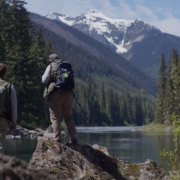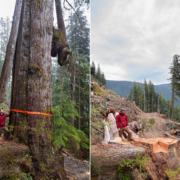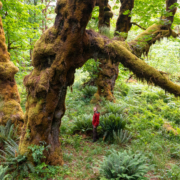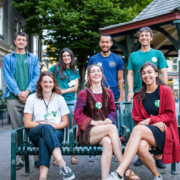February 18, 2025
By Julie Gordon
The Narwhal
BC’s private forests aren’t subject to the same logging regulations as those on public land — putting old growth, wildlife habitat and significant ecosystems at risk
See original article here.
“You have these 300-year-old bigleaf maples, completely draped in hanging sheets of moss and ferns,” Ken Wu, executive director the Endangered Ecosystems Alliance says. “Every single square centimetre is covered with moss — they look like ancient beings.”
Wu is describing a 13-hectare tract of old-growth deciduous rainforest, nicknamed Mossy Maple Grove, that runs alongside a creek just south of Cowichan Lake on southern Vancouver Island.
“You have Roosevelt elk all through the area, big herds of large ungulates,” Wu continues. “And where you get large herbivores, you get large carnivores. So, you have the wolves and cougars in the area too, and spawning salmon in the adjacent stream.”
For more than 30 years, Wu has been working to protect significant and at-risk ecosystems. He says the grove and other small, fragmented forest stands on southern Vancouver Island represent some of the most “ecologically and culturally significant ecosystems in the province.” But because they are situated on fee simple — or privately owned — land, they have historically been some of the most at-risk.
That’s because private forests are subject to far less stringent regulations than publicly owned forests in BC According to Wu and others, lax regulations for privately owned forests threaten species at risk of extinction, Indigenous land rights, climate security and the economy. “It’s a much weaker system of an already weak system,” Wu says. “It’s closer to a free-for-all.”
Mike Ekers, an assistant professor in the University of Toronto’s department of human geography, agrees. Ekers has researched BC’s forestry industry for the past 15 years and is also concerned about the lack of regulatory oversight and reporting requirements for private forests in the province. He says that provincial reporting dating back nearly a century has indicated that “forestry practices were much, much more egregious, much more devastating on private lands than they were on Crown land. And this has continued to be the case.”
Here’s what you need to know about BC’s privately owned forests.
Where are most of BC’s privately owned forests?
About 95 per cent of land in BC is called “Crown land,” though most of it is not covered by treaties and was never ceded to the Crown by First Nations. The remaining five per cent of the province — about 4.5 million hectares — is held in fee simple, or private, ownership.
According to the province, just over a million hectares, or around one per cent of BC, are classified as “private managed forests,” meaning they can be harvested for commercial purposes. Other private lands are designated as forests, but don’t have a “managed forest” designation and cannot be harvested.
The vast majority of private managed forests in the province — around 800,000 hectares — are on southern Vancouver Island. Set within a 32-kilometre-wide tract of land running north from the Saanich Inlet to the Comox Valley, these forests make up around one-fifth of the island’s overall land base.

In Cowichan Bay on Vancouver Island, home to the Hul’qumi’num-speaking First Nations, the surrounding forests are privately owned — the largest concentration of private forests in BC. Photo: Mike Glendale / The Narwhal
Most of the remaining private managed forests are in the Kootenays, while a small number are scattered throughout BC.
The origin of BC’s private forest lands dates to the early 19th century when lands were expropriated by the Crown for settlement, mineral exploration and the construction of railways. The most significant expropriation was 850,000 hectares of Coast Salish, Nuu-chah-nulth and Kwakwa̱ka̱ʼwakw territories on Vancouver Island for the construction of the E&N railway.
How are private forests in BC managed?
Forestry operations on Crown lands are governed by the Forest and Range Practices Act, introduced in 2004, which includes mandatory regulations around 11 environmental, social and cultural objectives. The act is administered by the Ministry of Forests and requires forestry operators to produce comprehensive stewardship plans, consult with First Nations and local communities and report regularly to the provincial government and the public.
In comparison, most private managed forests fall under the more streamlined Private Managed Forest Land Act. The act was introduced in 2003 and is administered by the Managed Forest Council, an independent provincial agency comprised of five appointed members: two by the province, two by the private forest land owners and a chair appointed by the other four members. This act does not require owners to report publicly on activities, engage local governments or First Nations in planning or create stewardship plans. Reporting by private forestry operators is done via a one-page annual declaration form directly to the council.
While reforestation is one of five “environmental values” to which private forest operators agree to commit, it’s relatively easy for owners not to follow through, says Eddie Petryshen, conservation specialist with Kootenay-based nonprofit Wildsight. For a fee, owners can switch the land designation before they list it for sale — meaning private land designated as forest can easily be switched to land to be sold for other purposes, like property development.
“It’s a strip and flip mentality,” Petryshen says.
How have private regulations affected forest cover?
According to Wu, the most egregious difference between public and private regimes is that the latter have no prescribed harvesting limits. “You can cut as much as you want, as fast as you want,” he explains.
With no limits to the volume of timber that can be harvested from private forest under the current legislation, Ekers says, “the old growth and the hyper-valuable timber that’s been protected through activism on the west coast of Vancouver Island has generally been liquidated” within privately owned forests.

Mike Ekers, an assistant professor in the University of Toronto’s department of human geography, says that nearly a century of provincial reporting shows that forestry practices on private lands are “much, much more egregious” than those on Crown lands. Photo: Carrie Davis / The Narwhal
A 2023 map from Sierra Club BC showed 35 per cent of Vancouver Island’s old growth had been destroyed since 1993.
While some protections have been achieved for Crown forests, these victories may have ratcheted up logging on private forests. Ekers points to Clayoquot Sound, where protests led by Nuu-chah-nulth nations ended most industrial logging on their traditional territories, which are called Crown lands by the province; in response, more pressure was put on the island’s private forests for timber resources.
Annual reports from the Managed Forest Council show a disproportionate amount of timber is harvested from private managed forests, which make up less than four per cent of the province’s harvested forest base. In the most recent report, 11.6 per cent of timber harvested in BC came from private forests within the Managed Forest Program.

Private forest lands in the Alberni Valley on Vancouver Island. Private forest lands contribute a disproportionate share of timber harvested in BC. Photo: TJ Watt / Ancient Forest Alliance
What environmental protections exist for private forests?
Private forest operators in BC have five management objectives related to environmental measures such as soil conservation and water quality. But critics say these objectives are too broad to be meaningful, and far more lax than those applied to Crown lands.
“There are no mandatory old growth and endangered wildlife and ungulate winter range protections,” Wu says. “The private managed forest lands don’t have the stringency regarding soils and erosion. They don’t have the same road engineering standards. And they don’t have the riparian strip protections nearly on the scale of Crown lands,” he says, referring to the vegetation buffers alongside bodies of water that protect from erosion and runoff.
In an emailed statement, a representative for Mosaic — an operator that manages 71 per cent of private forest land in BC — said the company’s forestry operations are certified by the Sustainable Forestry Initiative, an organization operating in Canada and the United States that sets standards for forest operators.
But Ekers says the initiative’s standards are far less robust than other forest management certification systems, such as Forest Stewardship Council certification. He describes the sustainable forestry initiative as “more voluntary” and “much weaker.”
“It doesn’t really do anything other than provide legitimacy for companies that use it. It’s greenwashing through and through.”

In Wynndel, B.C., community members are concerned about the impacts of logging on the Duck Creek watershed, which supplies their water. In 2019, a BC judge ruled that communities have no right to clean water. Photo: Louis Bockner / The Narwhal
Is there anything British Columbians can do if they’re affected by private logging?
Communities concerned about logging on private forests have limited options — even if the logging affects them directly.
In 2019, the rural community of Glade fought logging in the watershed that supplied their drinking water, bringing a challenge to the BC Supreme Court. Ultimately, the judge sided with the logging companies. “Do you have a right to clean water?” Justice Mark McEwan asked. “I’d suggest you don’t.”
In the town of Wynndel, a two-hour drive from Glade, community members are once again raising concerns about the water supply as a timber company prepares to log the area surrounding their watershed.
How are First Nations rights impacted?
First Nations whose traditional lands are held in fee simple title have lost access to important foods, cultural and spiritual sites and resources and been undermined in their efforts to effectively steward or assert their inherent title over their territories.
Both the province and Canada have staunchly maintained that private property is off the negotiating table in land claims discussions, a position solidified in BC the controversial 2002 referendum. This has thwarted the efforts of treaty-seeking First Nations, such as the Hul’qumi’num Treaty Group’s five Coast Salish nations whose traditional territory was nearly entirely appropriated as part of the 1887 E&N grant.
“After almost 30 years into the [treaty] process, we have not been able to come to any kind of an agreement on how to deal with the biggest challenge that we have in our treaty negotiations, which is the private land issue,” Robert Morales, chief negotiator for the treaty group, says.

Robert Morales, chief negotiator for the Hul’qumi’num Treaty Group, says the issue of private lands is the single biggest challenge in the group’s treaty negotiations. Photo: Mike Glendale / The Narwhal
Ekers says the Private Managed Forest Land Act doesn’t make provisions for cultural, spiritual or recreational values to be protected. “Nowhere in the act is there a policy or practice related to cultural protection, or the meaningful participation of Indigenous nations.”
In 2008, the BC Supreme Court ruled that the Crown had a duty to consult and accommodate issues such as access to sacred sites, hunting and harvesting cedar and traditional medicines. However, that decision was not without caveats, according to Estair Van Wagner, a professor of law at the University of Victoria, who writes, “Judicial consideration of Indigenous relations with place has focused on the duty to consult and accommodate with respect to ‘Crown land’ … This emphasis has come at the expense of attention to Indigenous property relations in areas that have been largely privatized.”
What’s the future of private managed forests in BC?
Widespread concerns by citizens, municipal and First Nation governments, academics, environmentalists and outdoor recreation enthusiasts led the province to initiate a review of the Private Managed Forest Land Act in 2019.
Public feedback indicated support for the program by private forest owners, but everyone else had concerns. Key issues were impacts to local watersheds, lack of accountability, First Nations’ access to traditional resources and spiritual sites and protections for wildlife, recreation and environmental values. The most common theme among comments was that the regulations did not do enough to protect the environment. However, no changes to the act have been made since the review.

A home in Wynndel, BC sits beneath a 480-acre piece of land that was privately logged in 2018. Photo: Louis Bockner / The Narwhal
In an emailed response to a question about whether any changes to the act are forthcoming, a representative from the Ministry of Forests did not answer directly, but told the Narwhal, “Issues raised during the review of the Private Managed Forest Program are being addressed through actions, such as conserving more old forests, including through the $1-billion Nature Agreement and a new Biodiversity and Ecosystem Health Framework,” and by supporting local forestry jobs through support for “made-in-BC wood manufacturing.”
The newly re-elected NDP party promised to uphold commitments to the Nature Agreement and biodiversity strategy, as well as to implement protections for watersheds and old growth. However, it remains unclear if the Private Managed Forest Land Act will be amended.
What about privately owned old growth in BC?
While BC once had 25 million hectares of old-growth forest, ecologists concluded in 2020 that just 35,000 hectares of the largest, most productive trees remained, disputing the provincial government’s estimate of 11.1 million hectares of old growth as “misleading.”
In 2022, private forest manager Mosaic introduced the BigCoast carbon credit initiative, which aims to defer harvesting on almost 400,000 hectares of private land, trading the timber revenues for the sale of carbon credits. The program is on hold pending a technical review, but for now, Mossy Maple Grove and a few other privately-held old-growth stands on Vancouver Island still get a reprieve from logging until 2057.
While BigCoast has come under some scrutiny for its ability to reduce carbon, Wu says the logging deferrals provide a much-needed opportunity to find a longer-term solution. “We don’t think that carbon offset projects are a surrogate for real protected areas. They can be a stepping stone to keep these areas under essentially a moratorium on logging until the private lands can be purchased [for the creation of] new protected areas, including Indigenous Protected Areas,” he said.
And for private forests outside Mosaic’s management, it’s business as usual.
With files from Steph Kwetásel’wet Wood











